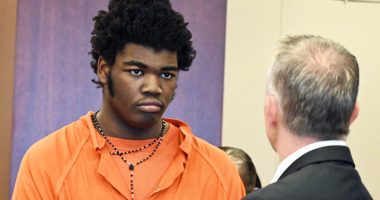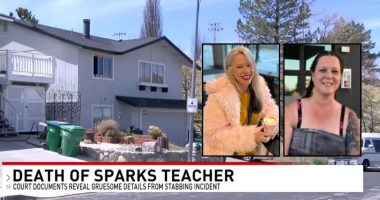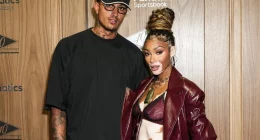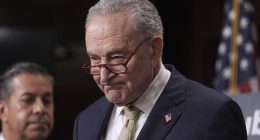
Sam Kerson (via Sam Kerson Art Gallery).
A federal appeals court ruled against an artist who created murals criticized for depicting enslaved African people in a racist manner, thereby allowing the murals to be covered and permanently hidden from view over the creator’s objection.
The Vermont Law School commissioned two murals in 1993 by now-73-year-old Canadian artist Sam Kerson — a muralist who is known for focusing on themes of social justice. The 8 feet by 24 feet murals were meant to celebrate Vermont’s role in the Underground Railroad, and Kerson painted them directly onto the designated walls at the law school.
“Slavery” depicted scenes of African people being captured and sold into slavery. “Liberation” contains images of Harriet Beecher Stowe, John Brown and Frederick Douglas, and shows Harriet Tubman arriving in Vermont and being provided with safe haven. The murals were initially well-received, but by 2001, observers began to speak up about racist caricatures appearing in the works.
“Among the concerns, viewers perceived the Murals as depicting enslaved African people ‘in a cartoonish, almost animalistic style,’ with ‘large lips, startled eyes, big hips and muscles eerily similar to ‘Sambos’ or other racist . . . caricatures,”” Chief 2nd U.S. Circuit Court of Appeals Judge Debra Livingston wrote in a unanimous opinion (citations omitted). “Beyond these stereotypical representations, some also took issue with the Murals’ depiction of ‘white colonizers as green, which disassociates the white bodies from the actual atrocities that occurred.’”
The law school responded to student concerns in 2014 by installing plaques next to the murals explaining their “intent to depict the shameful history of slavery as well as Vermont’s role in the Underground Railway.” In the summer of 2020, after the murder of George Floyd in police custody, calls to remove the murals escalated, and more than 100 students, alumni, faculty and staff demanded that the artwork be removed and replaced.
Law school officials placed a curtain in front of the murals, then erected a wall of fabric-cushioned acoustic panels in front of the murals to obscure them from view without physically destroying the art.
Kerson sued the school, claiming that the school violated the Visual Artists Rights Act of 1990 (“VARA”) which prohibits the “destruction … distortion, mutilation, or other modification” of art without artists’ consent, which prohibited VLS from painting over the murals entirely. Kerson lost at the summary judgment phase in district court and appealed.
The unanimous three-judge panel upheld that decision, siding with VLS and ruling that the school’s blocking the murals from view does not illegally “destroy” or “modify” the works under VARA and that federal law “does not afford artists a categorical right to demand that their works remain on display.”
Livingston, a George W. Bush appointee, wrote for the unanimous panel which also included Chief Circuit Court Judge José Cabranes, a Bill Clinton appointee, and U.S. District Court Judge Rachel Kovner, a Donald Trump appointee. Livingston looked to the plain language of VARA and ruled that the panels used by the school to conceal the murals “did not physically alter them whatsoever, let alone ruin them or render them unrepairable.”
Read Related Also: ‘Anti-LGBTQ rhetoric has a price’: Fashion designer and mother of 9 gunned down by man who made ‘disparaging remarks about a rainbow flag’ she hung outside her boutique
“Thus, [the law school] plainly did not destroy the murals by erecting a barrier shielding them from view,” Livingston said.
Livingston elaborated to explain that the kind of “modification” prohibited by would include alternations such as adding brush strokes or erasing content — but that merely concealing a work of art would not “modify” it.
Livingston said Kerson’s argument simply went too far and amounted to an “overread[ing]” of the statute.” The judge allowed that Vermont Law School would be barred from “intentionally or grossly negligently destroying the Murals and from modifying them so as to prejudice Kerson’s honor or reputation,” but that it was within its rights to erect a barrier to keep the murals from view.
VARA, which was passed in 1990, does not apply to artwork created before its passage. Therefore, it does not apply to works such as Confederate statues, monuments to Christopher Columbus, or other pre-1990 art.
You can read the full opinion here.
Steven Hyman, attorney for Kerson, said in an email Monday that he and his client were disappointed in what Hyman called the court’s “restrictive” interpretation of VARA.
“The very purpose of VARA was to preserve, protect art and to prevent changes to the art that would prejudice the honor and integrity of the artist,” Hyman said. “Permanently entombing murals over 8′ x 24′ that cannot be moved and can never be seen again is contrary to what Congress clearly intended in enacting the statute.”
Hyman said he was considering all options going forward.
Editor’s note: This piece was updated from its original version to include comment from counsel.
Have a tip we should know? [email protected]







